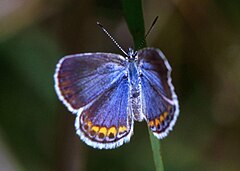Karner Karma, and more, in WI DNR publications
Karma is thriving inside the Wisconsin DNR, so enjoy it along with me.
You may remember that developer and former GOP State Senator Cathy Stepp successfully auditioned through a snarky, anti-science blog op-ed for the DNR Secretaryship she enjoyed for nearly seven years before Donald Trump moved her to a bigger sandbox to pollute:
Among more than a dozen success stories is this one which would give Stepp heartburn:

And while the Governor and his GOP-run Legislature want business to be able to fill wetlands and dig mines near rivers and streams, the report highlights many examples of land preservation that invite hikers and tourists to enjoy an enriched environment:
You may remember that developer and former GOP State Senator Cathy Stepp successfully auditioned through a snarky, anti-science blog op-ed for the DNR Secretaryship she enjoyed for nearly seven years before Donald Trump moved her to a bigger sandbox to pollute:
Those of you that haven't had the pleasure of peeking behind the scenes of our state agencies like DNR, Health and Family Services, etc...need to know how some of the most far-reaching policies come down on our heads...suffice it to say that many of these great ideas (sarcasm) come from deep inside the agencies and tend to be reflections of that agency's culture
For example, people who go to work for the DNR's land, waste, and water bureaus tend to be anti-development, anti-transportation, and pro-garter snakes, karner blue butterflies, etc...This is in their nature; their make-up and DNA. So, since they're unelected bureaucrats who have only their cubicle walls to bounce ideas off of, they tend to come up with some pretty outrageous stuff that those of us in the real world have to contend with.Now let me point you to the DNR's Natural Heritage Conservation Program 2017 Annual Report, a lovely document touting many positive DNR staff and volunteer initiatives statewide.
Among more than a dozen success stories is this one which would give Stepp heartburn:
Wisconsin has more Karner blue butterflies than anywhere else in the world, and NHC continues restoring habitat for this endangered species. For example, a 34-acre area of Coon Fork Barrens State Natural Area is now exploding with lupine and other plants critical for Karners following a recent prescribed burn; butterfly numbers increased at this site too.
With restoration projects planned through this fall/winter, Karners will gain more than 900 acres of improved habitat, which will also benefit a host of other species, by the end of 2017.

And while the Governor and his GOP-run Legislature want business to be able to fill wetlands and dig mines near rivers and streams, the report highlights many examples of land preservation that invite hikers and tourists to enjoy an enriched environment:
BOOSTING HABITAT ON PRIVATE LANDS
MONKSHOOD UNCOVERED
NATURAL AREA ADDITION BENEFITS RARE SPECIES
And it's hard to miss the contradiction between the DNR management working hard - - comment deadline is Friday, so weigh in - - to help a Walker donor to tear apart a wetland/woodland/artifact/dune-rich 247-acre nature preserve right next - - and even intruding into - - Kohler-Andrae State Park - - and this feature item in the Natural Heritage Conservation Program 2017 Annual Report:
WISCONSIN HAS THE NATION’S LARGEST AND OLDEST SYSTEM OF NATURE PRESERVES
and more of them got the help they needed in 2017 as NHC field staff controlled brush and invasive plants, conducted prescribed burns and arranged timber harvests on a record 12,445 acres.
Such management is particularly important for maintaining Wisconsin’s best remaining prairie and oak savanna and barren remnants and providing refuge for the endangered plants and animals that depend on such habitat.
By the way: while you can enjoy the report online, I have to mention that I first saw it as an insert in the December 2017 issue of Wisconsin Natural Resources magazine - - the publication which Walker and then-DNR Secretary tried and failed to kill.
Which led to an increase in subscriptions, and no doubt wider distribution of the Natural Heritage Conservation Program's work, goals and 2017 Annual Report, to new readers, like me.
Karma.









1 comment:
You and your readers saved the magazine. It has changed and will change again but it is still alive and you deserve all the credit. Thank you.
Post a Comment